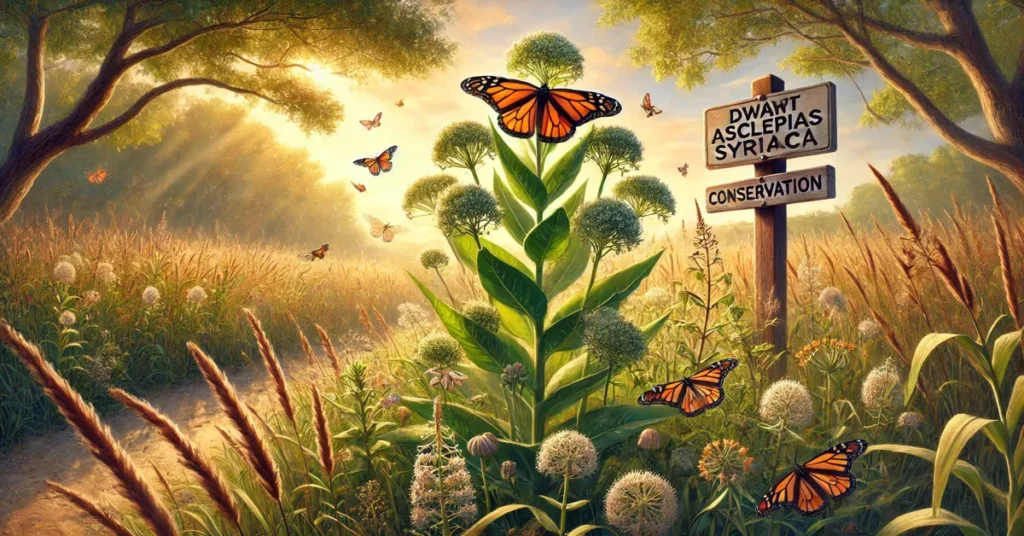Introduction
Asclepias syriaca, commonly known as common milkweed, is a native North American plant celebrated for its ecological importance, particularly in supporting monarch butterfly populations. However, dwarf Asclepias syriaca refers to a compact or smaller variant of this species, adapted for more restricted spaces like home gardens, urban settings, and restoration projects. While much of the attention is on the full-sized variety of Asclepias syriaca, the dwarf variant brings its own unique benefits and applications to both natural ecosystems and managed landscapes.
In this article, we explore the dwarf Asclepias syriaca, its environmental role, its benefits to pollinators, and how it can be used in a variety of settings, from wildflower meadows to small-scale gardens.
What is Dwarf Asclepias Syriaca?

Definition and Characteristics
Dwarf Asclepias syriaca is a smaller, more compact form of the traditional Asclepias syriaca. While the full-sized milkweed can grow up to 1.5 meters (5 feet) tall, the dwarf variant typically remains under 0.6 meters (2 feet). This makes it a more manageable plant for gardens and areas where space is limited.
The dwarf variant shares the same defining characteristics as its larger counterpart. It has broad, oval leaves that exude a sticky, milky sap when broken. Its flowers are fragrant, arranged in dense clusters, and range from pale pink to purple. These flowers bloom in late spring through summer, attracting a wide variety of pollinators.
One of the most important features of dwarf Asclepias syriaca, like other milkweed species, is its role as a host plant for the monarch butterfly (Danaus plexippus). Monarch butterflies lay their eggs on the leaves of the plant, and the caterpillars feed exclusively on milkweed, making it essential to their life cycle.
Ecological Role of Dwarf Asclepias Syriaca

Supporting Pollinators
One of the most significant ecological roles of dwarf Asclepias syriaca is its support of pollinators. Like other milkweed species, it provides nectar to a variety of insects, including bees, butterflies, and moths. Its sweet-scented flowers are particularly attractive to pollinators, contributing to the health of both local pollinator populations and the wider ecosystem.
The structure of the milkweed flower is specifically adapted to facilitate pollination. Each flower has five hoods that protect the nectaries, and these hoods are accompanied by slender horns that rise from the base. Pollinators are drawn to the nectar inside the hoods, and as they probe for food, their legs can become trapped in the narrow slits between the hoods, transferring pollen as they move from one flower to another.
The nectar-rich flowers of dwarf Asclepias syriaca ensure that it is a key plant in pollinator gardens and conservation projects aimed at bolstering bee and butterfly populations.
Host Plant for Monarch Butterflies
Perhaps the most well-known role of dwarf Asclepias syriaca is as a host plant for monarch butterflies. Monarchs are heavily reliant on milkweed species to complete their life cycle, as their caterpillars feed exclusively on milkweed leaves. This plant provides not only food but also the necessary chemical defenses that protect the monarchs from predators.
The milky sap of the milkweed contains toxic compounds called cardenolides, or cardiac glycosides, which are ingested by the monarch caterpillars. These toxins make the caterpillars and the adult butterflies distasteful to potential predators, providing them with an evolutionary advantage. The close relationship between monarch butterflies and dwarf Asclepias syriaca highlights the importance of preserving and cultivating milkweed species in both natural and cultivated environments.
In recent years, monarch butterfly populations have faced significant declines due to habitat loss, pesticide use, and climate change. Planting dwarf Asclepias syriaca in gardens, parks, and restoration areas can help provide the necessary habitat to support monarch populations, making it a critical tool in conservation efforts.
Supporting Biodiversity
The ecological importance of dwarf Asclepias syriaca extends beyond monarch butterflies. Its flowers attract a wide array of insects, including bees, beetles, wasps, and moths. The plant also provides habitat and food for small mammals, birds, and other wildlife that rely on native plants to thrive.
Because dwarf Asclepias syriaca is a native species, it plays an important role in maintaining local biodiversity. Native plants like milkweed are adapted to the local climate, soil, and ecosystem dynamics, making them more resilient and beneficial to wildlife than many non-native species. Planting and maintaining native species like dwarf Asclepias syriaca is essential for supporting healthy ecosystems and ensuring that native wildlife, including pollinators and herbivores, have the resources they need to survive.
Dwarf Asclepias Syriaca in Gardening and Landscaping

Ideal for Smaller Spaces
One of the primary benefits of dwarf Asclepias syriaca is its compact size, which makes it a suitable option for gardeners and landscapers who want to incorporate milkweed into their spaces but lack the room for full-sized varieties. The plant’s smaller stature allows it to fit comfortably in smaller garden beds, urban spaces, or container gardens, while still providing the ecological benefits of its larger counterpart.
In urban settings where space is at a premium, planting dwarf Asclepias syriaca can help create pollinator-friendly environments that contribute to the overall biodiversity of the area. Whether in community gardens, green roofs, or along city streets, this plant can play a role in enhancing urban green spaces.
Maintenance and Care
Dwarf Asclepias syriaca is a relatively low-maintenance plant, making it an excellent choice for gardeners of all skill levels. It thrives in well-drained soil and prefers full sun, though it can tolerate partial shade. The plant is drought-tolerant once established, requiring minimal watering, which makes it well-suited to areas with dry conditions or for gardeners looking to reduce water usage.
One key aspect of maintaining dwarf Asclepias syriaca is to avoid the use of pesticides, particularly those that target caterpillars. Since this plant serves as a host for monarch caterpillars, using chemical pesticides can harm these beneficial insects. Organic gardening practices, including manual pest removal or the use of natural predators, are recommended to protect the caterpillars and other pollinators that rely on the plant.
Propagation and Growth
Dwarf Asclepias syriaca can be propagated through seeds, which can be collected from the plant’s seed pods in the fall. The seeds should be cold stratified for about 30 days to improve germination rates. This process mimics the natural conditions the seeds would experience in the wild during winter.
Once stratified, the seeds can be sown directly into the garden in early spring or started indoors to be transplanted later. The plant typically takes a few years to reach full maturity, but once established, it can self-seed and spread over time, contributing to the establishment of a healthy, self-sustaining milkweed population.
Conservation and Environmental Importance

Role in Monarch Conservation
Monarch butterfly populations have declined by over 80% in recent decades, largely due to the loss of milkweed habitat across North America. The widespread use of herbicides in agricultural areas, coupled with urban development and land-use changes, has led to the destruction of vast areas of milkweed, which monarchs rely on for breeding.
Planting dwarf Asclepias syriaca is one way that gardeners, conservationists, and land managers can help restore habitat for monarchs. While large-scale restoration projects are necessary to address the loss of milkweed on a continental level, small-scale efforts in home gardens and urban environments can still make a significant impact.
Even small patches of milkweed can provide critical breeding grounds for monarchs, particularly in areas where natural habitat has been lost. By planting dwarf Asclepias syriaca in backyards, parks, or public spaces, individuals can contribute to the conservation of this iconic species.
Supporting Pollinator Pathways
In addition to supporting monarchs, planting dwarf Asclepias syriaca can help create pollinator pathways, which are essential for the movement and survival of many insect species. Pollinator pathways are corridors of habitat that allow pollinators to move between feeding and breeding areas, helping them find the resources they need to survive.
As urbanization continues to fragment natural habitats, these pathways become increasingly important. Gardens, parks, and roadside plantings that include dwarf Asclepias syriaca can serve as stepping stones for pollinators, ensuring that they can travel between larger areas of habitat without becoming isolated or starving.
The Future of Dwarf Asclepias Syriaca in Sustainable Landscaping

Urban Greening and Green Infrastructure
As cities and towns strive to become more sustainable, incorporating native plants like dwarf Asclepias syriaca into urban landscapes can play a crucial role in promoting biodiversity and enhancing ecosystem services. Green infrastructure projects, such as green roofs, rain gardens, and urban wildlife corridors, are increasingly being used to manage stormwater, reduce heat islands, and improve air quality.
Native plants like dwarf Asclepias syriaca are particularly valuable in these projects because they are adapted to local climates and require fewer resources, such as water and fertilizers. By including this compact milkweed species in urban greening initiatives, cities can create more resilient and sustainable ecosystems that support both human and wildlife populations. The dwarf Asclepias syriaca provides habitat for pollinators like bees and butterflies, while also contributing to improved air and soil quality. This plant’s ability to thrive in low-maintenance environments makes it an ideal candidate for green infrastructure projects aimed at increasing biodiversity in urban areas.
Wildlife Gardens and Biodiversity Corridors
Dwarf Asclepias syriaca is a valuable addition to wildlife gardens and biodiversity corridors. These green spaces, whether in rural or urban areas, are designed to support native species by providing food, shelter, and breeding grounds for wildlife. The inclusion of dwarf Asclepias syriaca ensures that monarch butterflies, along with other pollinators, have access to the habitat they need for survival.
By creating a network of wildlife-friendly spaces, dwarf Asclepias syriaca can help connect fragmented habitats and enhance the movement of species across the landscape. This is particularly important in the face of habitat loss due to urbanization, agriculture, and climate change. The presence of this milkweed species in biodiversity corridors helps maintain healthy populations of pollinators and other beneficial insects.
These corridors not only support wildlife but also benefit the broader ecosystem by enhancing ecosystem services such as pollination, pest control, and soil health. The compact nature of dwarf Asclepias syriaca makes it especially useful in smaller spaces or areas where traditional milkweed varieties might not fit, allowing more people to participate in biodiversity conservation efforts.
Challenges and Considerations for Dwarf Asclepias Syriaca
While dwarf Asclepias syriaca offers numerous environmental benefits, there are also challenges to consider when incorporating it into landscapes.

Susceptibility to Pests and Diseases
As with many plants, dwarf Asclepias syriaca can be vulnerable to certain pests and diseases. Aphids, for example, are a common pest that can infest milkweed species. These small, sap-sucking insects can weaken the plant and reduce its vigor if left unchecked. In some cases, aphid infestations can attract ants or other unwanted insects, creating a chain reaction of pest problems in the garden.
To manage pests on dwarf Asclepias syriaca, gardeners should avoid using chemical pesticides, as these can harm beneficial pollinators like monarch caterpillars. Instead, organic methods such as manually removing pests or using natural predators, like ladybugs, can help control aphid populations without harming the ecosystem.
Additionally, dwarf Asclepias syriaca can be susceptible to fungal diseases, particularly in areas with high humidity or poor air circulation. To prevent fungal problems, it’s important to plant milkweed in well-drained soil and ensure that there is adequate spacing between plants to allow for airflow.
Climate Adaptation
While dwarf Asclepias syriaca is generally hardy, its growth may be limited in regions that experience extreme temperatures or drought conditions. In areas with harsh winters, the plant may die back to the ground, though it often re-emerges in spring. In drought-prone areas, supplementary watering may be required to keep the plant healthy, especially during its first few years of growth.
Gardeners in colder or drier climates should consider the local conditions before planting dwarf Asclepias syriaca and may need to take additional steps to protect the plant during extreme weather events.
The Importance of Native Plants in Conservation
The story of dwarf Asclepias syriaca is part of a larger movement to recognize the importance of native plants in conservation and habitat restoration. Native plants like milkweed play a critical role in maintaining the balance of ecosystems by supporting native wildlife, promoting soil health, and contributing to water conservation efforts.

Benefits of Native Plants
- Ecological Fit: Native plants, such as dwarf Asclepias syriaca, are perfectly adapted to the local environment, requiring fewer resources like water, fertilizers, and pesticides. This not only makes them easier to care for but also reduces the environmental impact of gardening or landscaping efforts.
- Supporting Wildlife: Native plants provide the necessary resources for local wildlife, including food, shelter, and breeding sites. In the case of dwarf Asclepias syriaca, monarch butterflies and other pollinators rely on the plant to complete their life cycles.
- Resilience: Native plants are more resilient to local pests, diseases, and climatic conditions than non-native species. By planting species that are native to a region, gardeners and conservationists can reduce the likelihood of invasive species taking over and disrupting the ecosystem.
- Water Efficiency: Native plants, including dwarf Asclepias syriaca, are typically better suited to the water availability in their local environment. In areas with water scarcity, planting native species can reduce the need for irrigation, contributing to more sustainable water management.
Conservation Efforts and Public Awareness
Public awareness campaigns aimed at promoting the planting of native species, including dwarf Asclepias syriaca, have grown in recent years, driven by concerns about declining pollinator populations and habitat loss. Organizations focused on monarch conservation, such as Monarch Watch and the Xerces Society, emphasize the importance of milkweed planting as a key strategy to help reverse the decline of monarch butterflies.
Through community outreach, educational programs, and citizen science initiatives, more people are becoming aware of the role they can play in conservation efforts by planting native species in their own gardens and public spaces. By choosing to plant dwarf Asclepias syriaca, individuals can make a tangible difference in supporting local wildlife and promoting biodiversity.
Conclusion
The dwarf Asclepias syriaca is more than just a compact version of the common milkweed; it is an essential plant for promoting biodiversity, supporting pollinators, and contributing to conservation efforts. Its ability to provide habitat and food for monarch butterflies and other pollinators makes it an invaluable addition to gardens, urban landscapes, and restoration projects.
By incorporating dwarf Asclepias syriaca into landscapes, gardeners can play a direct role in supporting monarch butterfly populations, creating pollinator pathways, and promoting environmental sustainability. Whether used in a small backyard garden, a community green space, or a large-scale restoration project, this versatile plant offers both ecological benefits and aesthetic appeal.
As awareness grows about the importance of native plants in conservation, the dwarf Asclepias syriaca stands out as a key species that can help address pressing environmental challenges, from pollinator declines to habitat fragmentation. By planting and caring for this milkweed species, we can all contribute to a healthier, more resilient ecosystem for future generations.
Read More: Dwarf Dogwood Tree: Exploring Its Environmental Niche, Ecological Role, and Conservation

